New Mystery Yemen Cat
Posted by: Loren Coleman on January 22nd, 2009
Dr. Darren Naish evidences again what often happens when one gets into a bit of a reflective wave of postings. He finds he is talking about another strange cat today, via some new images forwarded his way. He shared the news with me early this morning.
Take a look at this one.
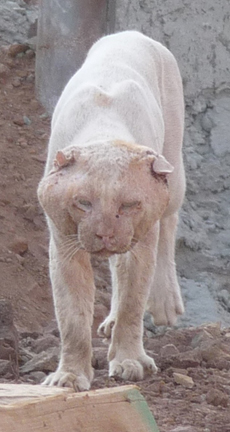
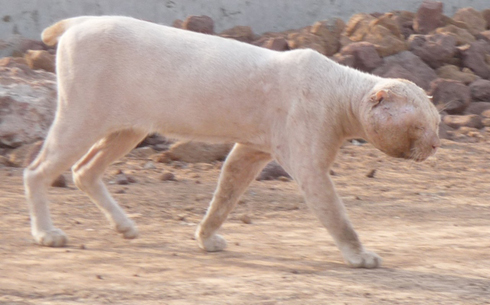
Darren writes:
Yesterday, I received some very interesting photos from Ryan Norris at the University of Vermont. As you can see, these photos feature a cat. A very, very weird cat.
* * *
Apparently this animal was photographed in south-eastern Yemen where it was frequenting a building site. The photos were taken by Jim Larsen. He reported that the cat wasn’t just hanging around the site, it was also chewing on cables; so much so that they had to take measures to stop the cables getting damaged further. That sounds pretty unlikely to me. In fact, it has that urban-myth quality about it, but what the hell.
I don’t think there’s any doubt that the animal in the photos is for real. Though no obvious scale is evident, it looks larger than a domestic cat.
For more of what Darren has to say about it, read here.
Look at the width of that head and the configuration of those ears?
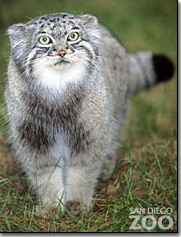
It immediately reminded of a Pallas’ cat (or Pallas cat, Felis manul), which is shown above, in one very healthy example from the San Diego zoo. Of course, the sense was only vaguely like a Pallas felid, because the overall hairiness, face, eyes, and tail of the Felis manul are much different than the pictured Yemen mystery cat.
Also, of course, there’s the matter of the shortened tail.
As far as domestic cats with small tails, there are several breeds nowadays with this trait, including Manx (those with no tails and the “Stumpy” with a small tail), Pixie Bob, Japanese Bobtail, and Kurilian Bobtail.
The last one, the Kurilian Bobtail (Kurilian, Curilsk Bobtailis, Kuril Bobtail) is a “natural” cat and a “mutated” cat. The breed, according to “Pictures of Cats,” is little known in the West but is the 3rd most popular breed in Russia, where there are about 40 breeding sites. The breed’s geographical origin is the Kuril and Sakhalin Islands, in the northwestern Pacific.
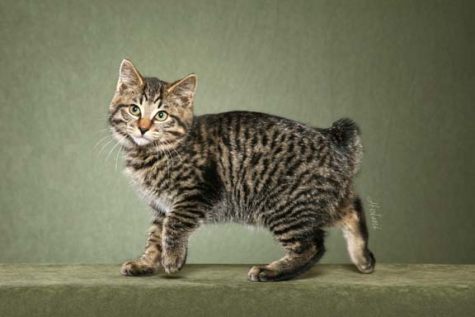
A Kurilian Bobtail kitten. Photograph by TAIGA/Helmi Flick.
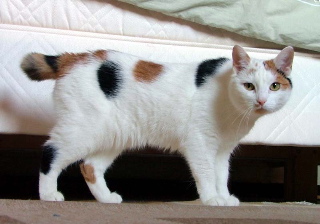
A manx breed cat with a stumpy tail. The cat, properly named Inka but more frequently referred to by her nickname Inkku, lived in Töölö, Helsinki, Finland. Photograph by Jonik.
So, it perhaps, are we to think this strange Yemen cat is nothing more than a mistreated, downtrodden, somewhat leucistic, shorthaired, bobtailed, feral domestic cat, after all? That chews on cables?

What do you think?
About Loren Coleman
Loren Coleman is one of the world’s leading cryptozoologists, some say “the” leading living cryptozoologist. Certainly, he is acknowledged as the current living American researcher and writer who has most popularized cryptozoology in the late 20th and early 21st centuries.
Starting his fieldwork and investigations in 1960, after traveling and trekking extensively in pursuit of cryptozoological mysteries, Coleman began writing to share his experiences in 1969. An honorary member of Ivan T. Sanderson’s Society for the Investigation of the Unexplained in the 1970s, Coleman has been bestowed with similar honorary memberships of the North Idaho College Cryptozoology Club in 1983, and in subsequent years, that of the British Columbia Scientific Cryptozoology Club, CryptoSafari International, and other international organizations. He was also a Life Member and Benefactor of the International Society of Cryptozoology (now-defunct).
Loren Coleman’s daily blog, as a member of the Cryptomundo Team, served as an ongoing avenue of communication for the ever-growing body of cryptozoo news from 2005 through 2013. He returned as an infrequent contributor beginning Halloween week of 2015.
Coleman is the founder in 2003, and current director of the International Cryptozoology Museum in Portland, Maine.










My very well fed Tabby cat chews electric wiring. I have had to replace phone wires, computer cables, headphones, etc. over the years. There appears to be no reason for it except it looks like string I suppose. Maybe cats sense something in the wires or they smell like mice 🙂
Otherwise this looks like a poor old Tom cat, scarred by fighting and abscesses, living rough. Cats can lose their tails quite easily, getting them shut in doors for example, so it is not unknown and of course there are cats born without a tail.
That cat’s head looks swollen to me, and quite unevenly at that. I’ve seen a dog’s head swollen that way and we assumed it was from an encounter with a copperhead.
I agree with that vamelungeon, it looks like that cat had an unfortunate encounter with a venomous snake with that degree of swelling. I have seen dogs in the past that tried to give copperheads or rattlesnakes a little sniff or lick and got bit on the nore or face and the results are very similar with severe swelling of the head. I guess there are a number of other things that could have caused that too, but this looks like nothing more than a local cat with a fat head.
I agree with cliffhanger and vamelungeon on this one. The cat pictured is definitely wounded. It does look a lot like a snake bite occurred. Poor kitty is definitely in pain. As for what kind of cat? Don’t know but it looks like a domestic cat or domestic gone wild cat.
He’s a battle-scarred, bobtailed feral. The ears are crumpled due to successive healed hematomas (“cauliflower ears”). The tail may be naturally bobtailed; bobtailed kittens are born fairly often. More likely, he lost his tail from an injury. Tomcats lose tails or parts of tails in fights pretty often.
Mature, intact tomcats have heavy jowls, but this guy’s jowls also appear to be further swollwen by abscessing. The sparse fur makes them look more prominent too. The swollen jowls make his body appear skinnier by comparison, but actually he looks quite healthy apart from his beat-up head. His tall, lanky build is typical of cats in desert regions.
As to chewing on cables – well, anyone who has a cat knows that they like to chew on wires and cables. There is something about the odor of some plastics that attracts cats and entices them to chew. They don’t say here that the cables it chewed on were plastic covered, but I don’t think a cat could do too much damage chewing on something entirely metal.
This poor guy is probably a king of the local feral toms, maybe on the way downhill, since he is beginning to hang around people where he can scavenge scraps. Feral cats – especially toms – tend to live short, brutal lives. This one looks well enough, apart from the abscesses – which can heal surprisingly quickly, even without treatment. He’ll probably go on to fight several more fights and maybe father a whole line of bobtalied kittens.
Great comments, so far.
Yes, apparently aural hematomas (“cauliflower ears”) in cats or dogs can result in some surprising outcomes:
are there other breeds of cats besides the ones out of Egypt that are without hair? As for the chewing of the cables…one of my cats is infamous for chewing the D.C. wires (those things with A.C. adapters), but for some reason has (to my knowledge) known to stay away from straight A.C. wires. I don’t even remember if she has chewed anything plugged in.
That cat is definitely a head tom. When I was young we had a feral tom wander thru our yard at night. One of those that yowled at every step. Creeped me out! Then I looked out and the poor thing was so badly scarred, it frightened me even more. This one definitely has swelling happening in the face. Beyond that, it could be one of thousands of breeds of cats. Remember, the people not too far off from where this cat is are some of the richest people in the world. Someone could have a thing for cats. Large groups of cats end up with slightly strange off spring and many go feral.
Man, what depressing pictures. Poor animal.
I think you’re confusing mystery with outright ugly…
Very Sad. I agree. He looks absolutely pathetic. Unfortunatly people in that part of the world, as in many others, are not particularly fond of or sympathic to cats or dogs. Being a huge cat lover it breaks my heart. 🙁
I cant help but notice that this cat seems much larger than the common domestic cat. Its features appear to be more along the size of a bobcat. I know that is nothing of scale in the pictures but the front legs look thick and muscular. The paws also appear to be large. Either way an interesting article and a weird find.
Yes, my first impression is of a short tailed cat that has had some run ins with other cats or wildlife. I don’t even think the swelling is necessarily due to a snake bite. It could be just abscesses, infections from sustained injuries, and the like. I don’t see anything in the dimensions of the body to make me think that this is anything other than a banged up feral cat.
The one thing that bothers me, and perhaps Kittenz has some thoughts on this, is the apparent lack of hair on much of the body. Of course, mange can cause this, but the skin looks smooth for that, and doesn’t look particularly scabbed over or scratched, which I would expect a little of in an animal with mange at this stage. Or is that just an even short coat of hair that gives the appearance of hairlessness?
Anyway, the hair is the thing that I am wondering about most. Is there a breed of hairless or very short haired bob tailed cat that could match with what we are seeing? Is it mange? I can’t really say from what I see here.
I’d guess by the height of the flat cement like plateau its a platform man made. I’d guess by using that ratio its several feet large. Its face sort of reminds me of a cougar. It might be an injured old cougar. I doubt it though.
Whatever it is it needs medical attention.
This is a poor old feral tom that has led a rough life. We had one in our neighborhood that had a massive head and jaws, lot of scars similar to this except he still had most of his hair. And he weighed on the order of 15 + pounds. There is nothing in the picture to allow a true sense of dimensions. Rubble close up and cropped can look like huge boulders (not saying the photographer is trying to pull a fast one here)
one of my pitbulls used to get this all the time after an accidental dog fight. One small puncture and the bacteria would make his whole jaw and side of his face swell up with abscess, requiring a rubber hose to drain.
Obviously there are a lot of animal lovers here who correctly called this one.
He isn’t hairless; he has a very short fur, like a Siamese or Oriental Shorthair, and although I can’t be certain, the color of the fur appears to be white with reddish markings in a Van pattern (with color restricted to the tail and head, and a few spots on the back). There may be some hair loss too, especially in the areas of the face affected by abscesses (a common occurence). The illusion of hairlessness is heightened by the bright exposure of the photo and the pale colors of the cat’s fur.
“Mange” is a generic term used to describe many skin conditions that are caused by mites (which are tiny arachnids related to ticks and spiders). The kind of contagious mange that causes total hairlessness in dogs, bears, coyotes, etc. – sarcoptic mange – is extremely rare in cats. When it does occur it usually affects only the head; in fact, in cats, sarcops is called “head mange”. I’m not sure why it affects only the heads of cats and not the whole body; nobody knows for certain, but I’d bet that it has something to do with cat’s intense grooming habits and the fact that they can reach every part of their bodies, except their heads, with their comblike tongue. They dislodge most slow-moving external parasites like mites before the mites can get embedded into the skin.
The most common form of mange in cats is otodectic mange, caused by ear mites, Otodectes cynotis. Usually hair loss from otodectic mange occurs on the ears only, but the mites embed and tunnel in the ear canal, causing intense itching, and many cats mutilate themselves by scratching their ears. The thick black gunk in an affected cat’s ears is diagnostic for ear mites. Eliminating the ear mites eliminates the ear mange. I get good results with a protocol of a pyrethrin ear wash followed by a betadine flush, then several drops of ivermectin directly into the ear canal, and finally a subQ ivermectin injection at the time of the initial treatment and then another injection 2 to 3 weeks later. Ear mites are very contagious, and since cats can’t effectively clean deep inside their own ears, the mites tend to take hold and they can return if they aren’t eliminated completely, or if the cat is exposed again. Often you see cats who are buddies grooming deeply into each other’s ears. This practice probably helps to keep the mites from taking hold and so would have been an evolutionary advantage. House cats and their feral kin are much more social that most other cats. I believe that reciprocal grooming to keep skin parasites at bay is one of the reasons for that.
Another, less common, mange that occurs in cats is Notoedric mange, caused by a tiny, microscopic mite, Notoedres cati. Notoedric mange can cause serious skin thickening and crusting, especially about the head. Affected cats’ skin can ooze with open sores which can become infected secondarily with bacteria or fungi. In really extreme cases the sores can lead to blood poisoning and even death. When notoedric mange is the problem, it will sail through a colony of cats like the wind, because it’s very contagious. When treating notoedric mange you need to try to treat every cat on the property – not usually possible in a feral colony.
Demodectic mange (“red mange”) only very rarely affects cats. When it does, it’s usually cats with suppressed immune systems, such as those affected by feline AIDS. There isn’t a really reliable cure for cats; the treatments that work so well on dogs are all fairly toxic to cats. Ivermectin works well but will not completely eliminate all the mites. Used in conjunction with Amitraz (Mitaban), you can acheive good results, but with Demodex, the mange comes back when the immune response is low, such as during times of stress.
There are several other types of mites that can cause skin problems in cats; fortunately none of them are very common. Where one does commonly see these infestations is in colonies of free-ranging ferals living close to human habitiation, or sometimes in the colonies of “collectors” – humans pathologically obsessed with hoarding as many cats as they can acquire. In conditions of unnatural crowding such as those, mite infestations thrive.
The bruiser in these photos appears to have head mange, but that could just be a trick of the light.
Kittenz- Exactly the kind of thorough, insightful response I expected from you. I appreciate the time you took to share these things. I am aware of what the term “mange” implies, what it is, and how it affects wildlife, but did not know a lot of the details as they pertain to domestic cats. Thank you very much.
On closer inspection, I can make out a VERY short coat of hair, but it still looks uneven and off to me. Yes, I thought that this cat looked as though it might have some sort of infestation of the type you mentioned last. It seems as though this cat could be living in the types of conditions where that sort of condition may be apt to occur, and its appearance gives that impression in my opinion. The cat seems to me to have some sort of hair loss condition to a certain extent, especially on the head, which seems to be practically completely hairless.
Although you say it is just a very short haired cat, it really does look like it has some sort of condition affecting its fur in places to me. I seem to be seeing more hair loss going on in these photos than you are. Are you sure that this cat has nothing wrong with its body hair? I’m not really disagreeing with your opinion, and I see what you mean, but it does seem remarkably low on hair, even for a short haired cat (and I’ve been perusing a good deal of photos of the breeds you mentioned), with the skin (and even splotches) apparently showing through quite dramatically in places.
If you say you are sure this is completely normal for some breeds of cats, I’ll go with you on that. There just seems to be something a bit off to me about its coat and I can’t quite pin down what it is (probably thinking way too much about it 🙂 )
Kittenz- Actually, allow me to correct myself. Upon just seeing some photos of white colored Oriental short haired cats that look very much like this, the body hair on this one looks Ok I suppose. I’m glad you pointed me in the right direction on this one. I really thought the hair looked off, but upon further research, I don’t think I can really say there is anything to justify that any more (although it still looks very pink too me. Oh well.)
Perhaps you are right that there is nothing else wrong with this cat except some abscesses and maybe a bit of head mange. This has been a pretty interesting thread for me, and I’ve learned a couple things. Thanks Kittenz. 🙂
Can’t speak for cables in Yemen, but here (Australia) telephone cables have vanilla in them, or did back in the 70’s/80’s at least. We had a pet rabbit who spent it’s whole life chewing them up for this reason. More recently our Burman cat has taken a liking to them.
Poor critter. Hope the swelling goes away.
I agree with Kittenz and Mystery_Man.
Kittenz had a great post, as always, explaining this.
mystery_man,
This poor fella may actually have some diffuse hair loss; it’s difficult to be sure. Certainly there is some hair loss in the abscessed areas. I’ve seen cats that had been scalded by boiling water, and when their fur was growing back, one of them had fur a bit like this cat’s. This one doesn’t appear to have any lesions anywhere on its body (aside from the head) except the front legs and shoulders, and that’s very typical of an intact feral tomcat who’s been fighting for awhile. There’s a lot of scarring on his front legs & shoulders too, from fighting. This guy is a veteran!
He probably isn’t any “breed”; he’s probably of mixed, uncertain ancestry, but he looks a lot like an old-fashioned Siamese in his body proportions. He even has a trace of a dewlap under the abdomen. Old-type Siamese have more rounded heads that the extreme showy types, and Siamese/Oriental – type cats are very muscular; when you pick them up they feel much heavier than they look.
I’d like to think that this beat-up old guy will find a home on someone’s hearth and end his fighting days.
Thanks for the kudos, cryptidsrus & mystery_man. I love cats, and analyzing this one has been a welcome distraction after a heartbreak.
My beautiful mother, who had fought so hard against cancer, and nearly had it beaten, has died suddenly and unexpectedly from pneumonia, on January 14. She had sufferred through so much, and the cancer was nearly gone, but her lungs were so damaged, and her health so fragile, that she was unable to overcome pneumonia that deteriorated into ARDS. She was a beautiful, intelligent, incredibly talented woman, and I will miss her forever.
Kittenz- Yes, I agree, I sort of figured that this cat was likely not of any specific breed, and of mixed ancestry. Again, thanks for your insights.
I must say that I am very sad to hear the tragic news about your mother. It came as quite a shock to read that, and my heart truly goes out to you and your family. I hope you will have the strength to get through this trying time. My sincerest condolences to you.
Kittenz, first, thanks for the very informative posts here. Very interesting. Second, please let me also extend my sincere condolences on your loss. I know words cannot ease what you feel, so I’ll just leave it at that.
I also would like to offer my sincerest condolences, Kittenz. 🙁
Thanks, everyone, for the condolences.
My mother was a wonderful person. She was a nurse, who spent her entire life helping others. She loved cats too, and she would have said this tough old fellow here needs a good feeding-up and a warm place by the fire 🙂 .
Obviously very sick from ear infections and probably abcessed teeth. Yes, a snakebite is a possibility, since most cats not purposely raised around them will not tolerate them and feral ones think they make a great lunch. Much wire covering is made with formaldehyde which attracts all sorts of animals to chew on it. The producers of the wiring, bags and other plastic items know and don’t care. The bob tail could be genetics or an accident. I love his body structure and the coloring is that of a Flame Point pointed cat, a color I love. In fact, I like him so much I would love a litter of kittens from him. If I had the money I would offer him a home if he could be trapped. But I’d have to win the lottery to afford the shipping from Yemen, much less the amount of veterinary treatment he would need. He probably has several sorts of internal parasites as well. If he can’t be trapped and money raised somehow to treat him VERY soon, he is going to die. I wish I could help him, but ….sigh. Can barely cover my own medical, much less as much as he will need.